Artist, seafarer, writer and social educator, Nibedita Sen has worked with people with spinal injuries, blind children and as well as children who have been sexually abused and disadvantaged. She has exhibited her work in India and abroad and her poems and writings have been published in anthologies, magazines and newspapers.
Her reflective research Gitanjali and Sea Inside: Parallel Journeys was sponsored by the Government of India (ICCR) as a solo-travelling exhibition to be exhibited in the Palais-de-glace at the National Museum of Art, Buenos Aires; Gallery Marcel Du-Champ, Belgrano, Buenos Aires; Salon Pados Perdidos, Parliament, Argentina and Nehru Centre, London. Her latest, Black of the Mind, a post-trauma stream-of-consciousness series, was shown at the Lalit Kala Academy.
Advertisement
Nibedita believes in exploring uncharted paths, leading to new challenges and newer sensibilities.
Sita and Radhika
My mother once said that girls named Sita are ‘Janamdukhi’--eternally sad—and warned not to name any daughter as Sita. I have been working on the topic of ‘Vanvaas’, where daughters are given away, or ‘sent off’ to in-laws’ houses, for good. Daughters are ‘parayadhan’, someone else's wealth, brought up by parents only to be sent on their way after marriage. The concept, needless to say, is prehistoric. How can a girl reinvent herself, appear ‘new’, so to speak, as wife, daughter-in-law, mother repeatedly? The process constantly depletes her intrinsic self so that at some point she forgets what she once was. This, of course, is what is expected of her. She must adapt at all costs. Any flaw in this process of surrender leads to her fall from the status of a ‘Devi’.
Advertisement
Sita was a much-loved princess before she chose her life-partner in a swayamvar. At her in-laws’ house, where various injustices befell her, no one from her father's house came to her rescue...a tradition that continues to this day. She was first exiled along with her husband--‘Sita's Vanvaas’ and ‘Sita's Exile’--then, much later, made to sit on a pyre for an ‘agnipariksha’. But all of this was under the veneer to maintain her status as a ‘Devi’, the chaste one. I feel most women, like Sita, accept their Vanvaas, following their fathers, brothers and husbands wherever they lead her to--an exile from the realities of life, against their own will, pushed away often from happiness. As a child found while tilling the earth, Sita was a gift from nature and thus to be treasured always.
Ill treated in her life, Sita, the precious gift of the earth, goes back into the bosom from where she issued forth.
She is not Sita. Radhika is different. She is the embodiment of freedom that every woman dreams of inhabiting. Freedom is the best garb that anyone can wear; all other clothing, jewellery and ornaments are just superficial. Radhika is an eternal embodiment of freedom, love and desire. On one hand she embodies beauty. On the other, she personifies an insatiable quest for the unattainable. She is therefore an enigma.
Radhika is a Gopini, married to a Gopi and is in love with Krishna, who had many wives. She is free from social inhibitions, because she doesn’t feel the need to ‘comply’. She only needs to follow her own quest, her inner search for excellence, epitomised by Krishna--the blue of water and space, the colour of the unfathomable sky and oceans…. My paintings of women as Radhika are done mostly in blue. And that is how they become quite inseparable in spirit.
Advertisement
This deep rooted quest to be free is universal. And it can happen only through liberation, with the shedding off of physical restrictions and social obligations. While Sita gives in to pressure, to conform to every demand of society, Radhika has freed herself from the need to ‘comply and surrender’ to bondage. Her lover Krishna, also free from any restrictions, is like her and both choose to be together in spite of all barriers. The beauty of Radhika and Krishna symbolises freedom. Radhika, therefore, is an exception, in that she has been able to empower herself to choose whatever she desires.
Why is Radhika always present as the earth-colour partner, as the eternal consort of the sky-ocean colour of Krishna? It is because without the earth there can be no ocean, no sky, nor air or fire. Every element is equally vital to, and is responsible for, another's existence. There is no subjugation in nature's spontaneous activities.
Advertisement
Radhika chooses to stand alone as one element, with every other element revolving around. She is any-woman and every-woman who chooses to be herself.
Here comes some of Nibedita's illustrations.

Sending off
Giving away a daughter and sending her off to her husband’s house for good is like an exile or ‘Vanvaas’.
This age-old custom still followed is a barbaric one. The pain of every exile lies is the fact that almost all moral support from close associates is suspended. She was left alone to face her misfortune.
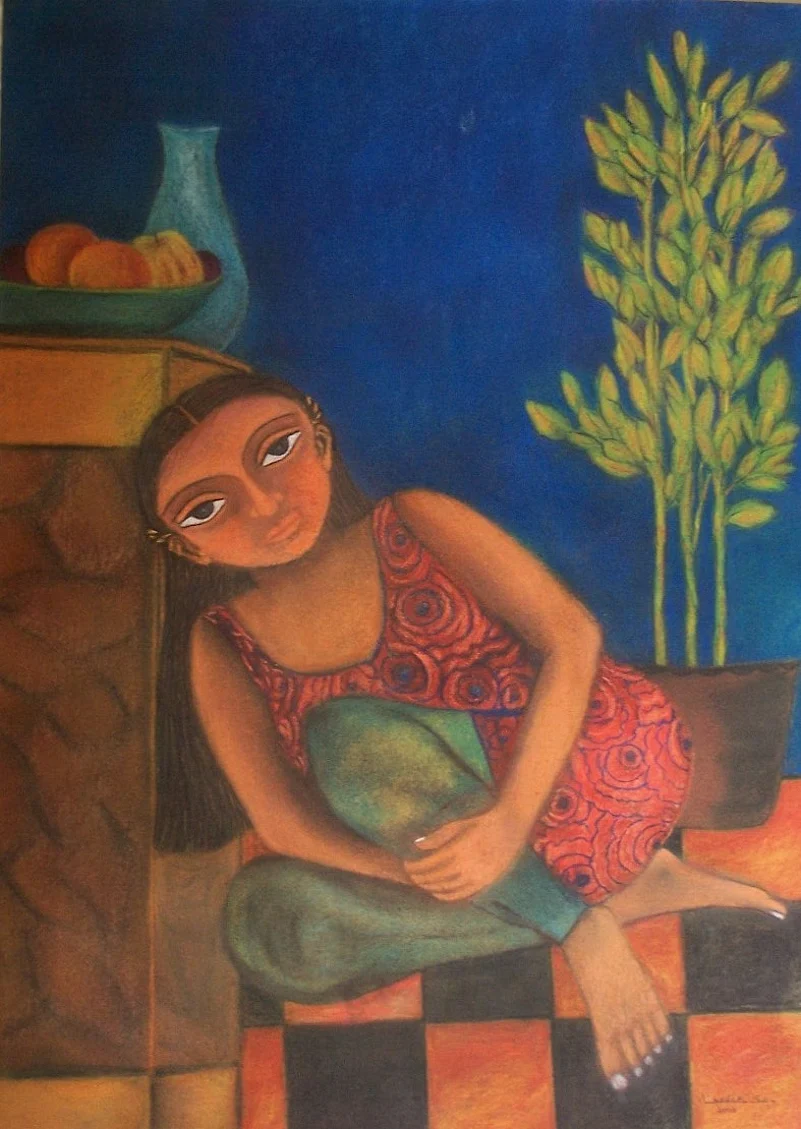
Sita is the archetype of a caged woman. She is the mother figure suffering silently, always smilingly compliant, lest she falls from her glorified ‘devi’ or mother status. Every woman surrendering herself to the brutal injustice of a sheltered life is a Sita in vanvaas.
Advertisement

Firefighters
Most women across the globe are continually fighting an invisible fire.
“Sita’s Agnipariksha” was to prove her chastity; the Jauhar of the women of Rajputana, to save themselves from alien men; a woman being pressured to join her dead husband in the same pyre in an act of Sati, or women fighting it out alone on roads, buses, trains, offices are the same. They are all firefighters.
Radhika
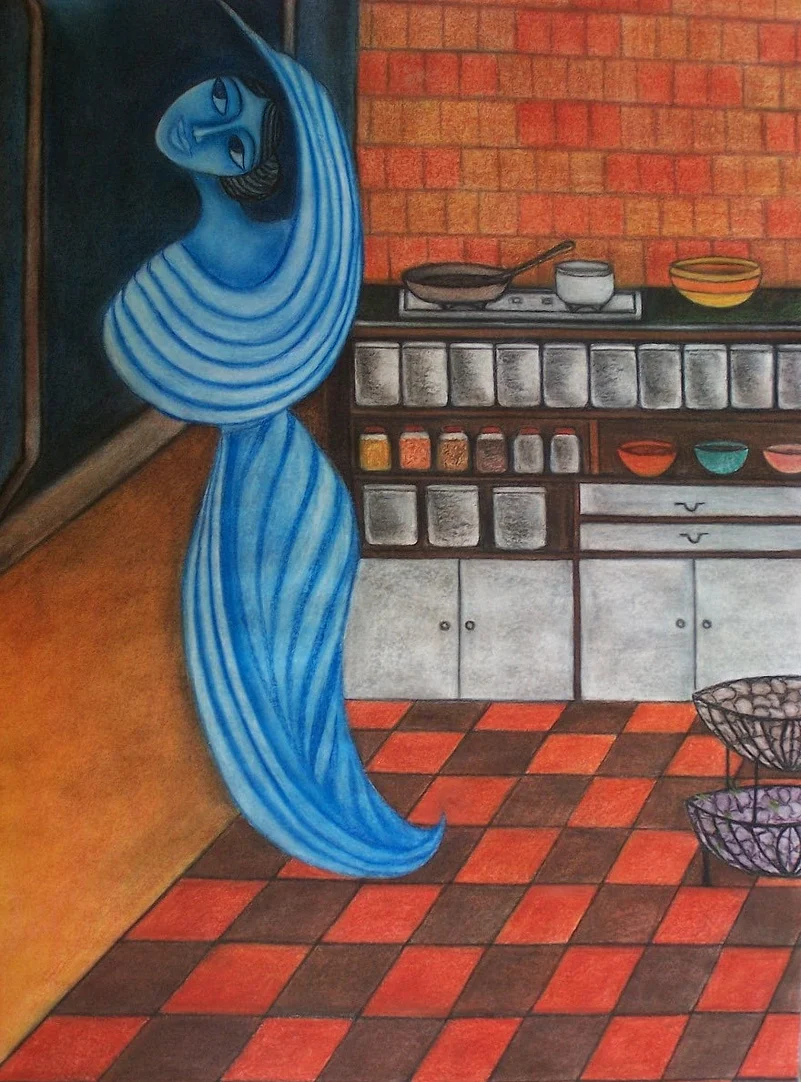
An embodiment of freedom, Radhika is the archetype for every woman dreaming to be free and liberated from bondage. Krishna is her pursuit. Freedom and Krishna are synonymous to me.
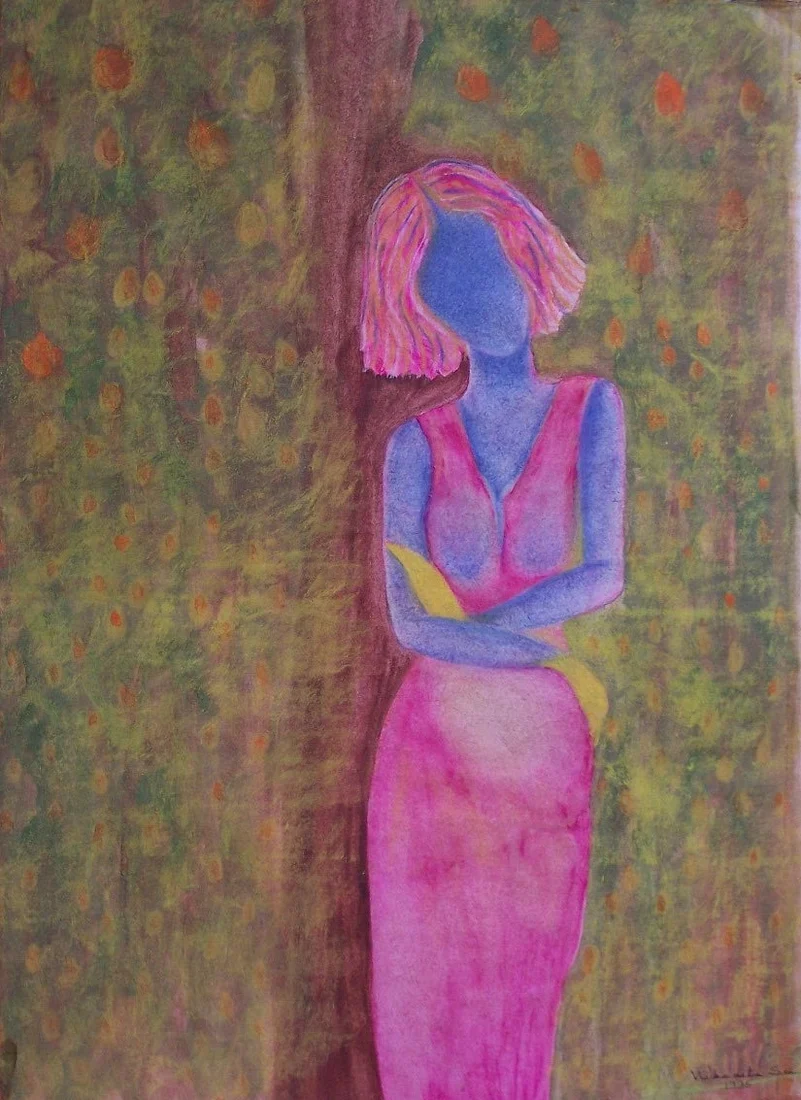
Done from the recollections of my student, who is physically blind. She is also a musician, always humming tunes of Indian ragas, engrossed in the harmony within herself and her passion for music. She is a Radhika in pursuit of perfect musical notes. And Krishna, the flautist, is the epitome of a perfect cosmic balance. Harmony and Krishna are one and the same.
Advertisement
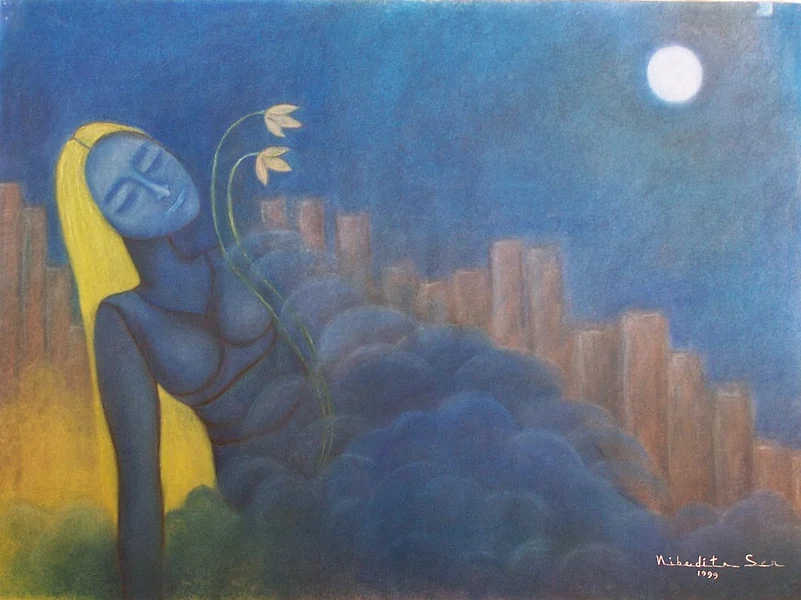
Goddess of desire, she represents the element of earth in every woman, desiring to be the most perfect and precious, and also acquire the most invaluable of consorts. Krishna is the unattainable, the one she desires.
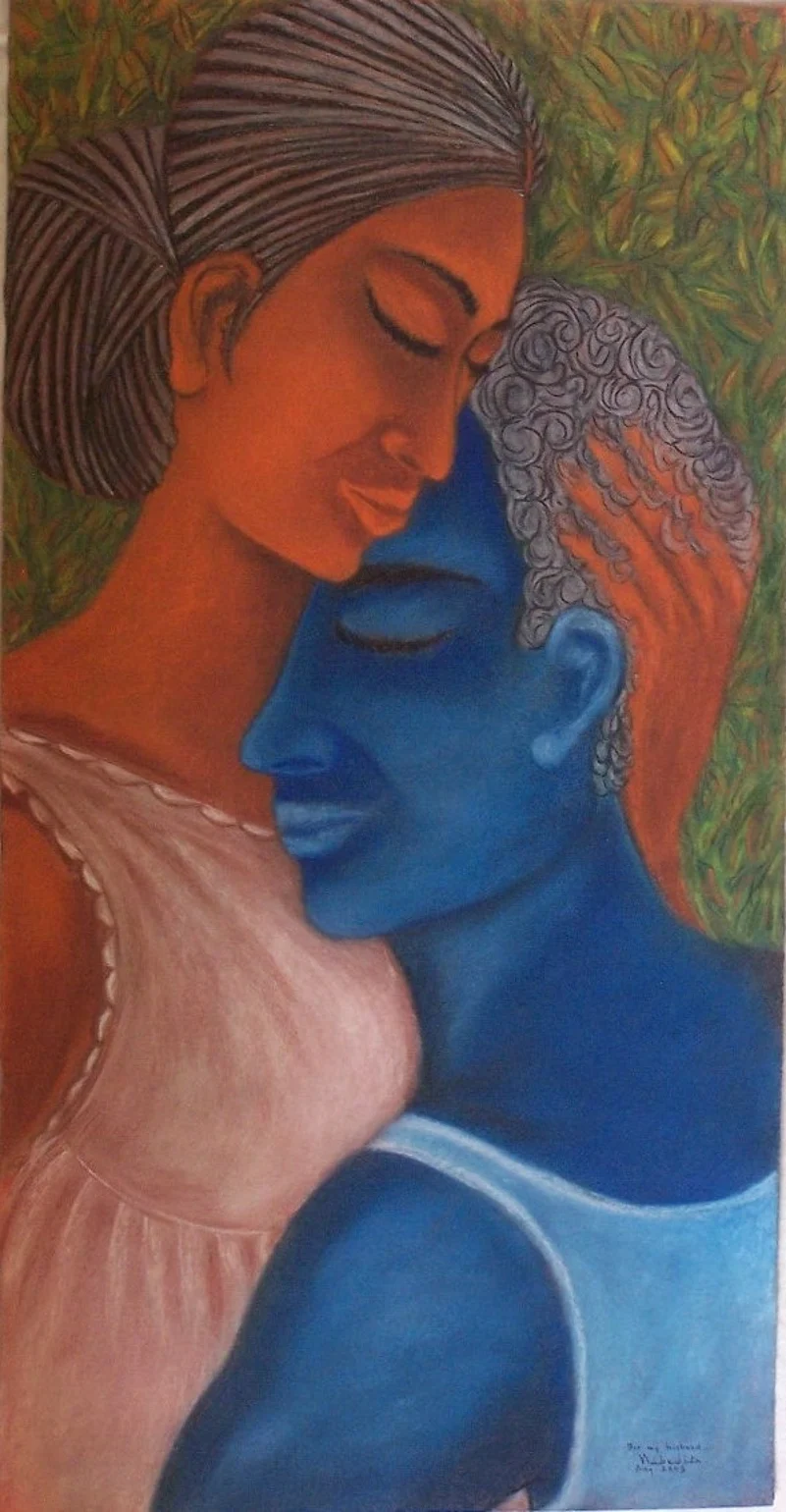
Krishna symbolises the blue of the sky. Women create their own, customised ‘private skies’, which function as their escape route from the mundane. Imbibing the sky, she sails over the clouds, above and beyond the concrete.

Reverse Draupadi
Deconstruction of the image and myth of the ‘texted’ Draupadi, who also suffered much indignity. She is actually a captive of circumstances, and also captive of her own instincts and emotions, represented by her five husbands, who she is fated to please. There is no ‘fall’ as far as life is concerned. There are only ‘compromises’ and ‘adjustments’ and there are reasons to comply and surrender.






.jpg?w=801&auto=format%2Ccompress&fit=max&format=webp&dpr=1.0)













